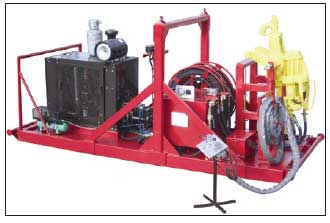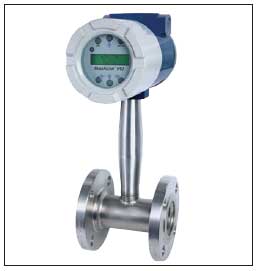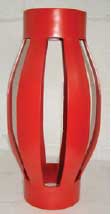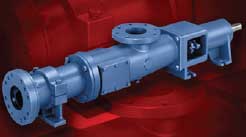New products
New product and service offerings from company press releases.
120-ton power swivel with offshore package
The hydraulic motor-driven Logan 120-Ton Power Swivel with Offshore Package provides smooth, accurately controlled, shock-free rotary power for use in fishing and workover operations-such as the internal or external cutting of tubing, casing or drill pipe; drilling out plugs, packers or cement; milling operations; and scraping casing. In addition to oil and gas wells, it is also effective for light to medium drilling applications. Suspending the swivel from a boom or crane reduces setup time. The system is also suited to coring operations. Any length of core may be taken, while accurate, smooth torque protects against damage to core tools or strings. The rugged, skid-mounted unit is made of heavy-duty structural tubing with welded construction. It is equipped with a containment lip to eliminate fluid spills. Both ends are rounded to facilitate skidding. The lifting frame, which is flush with the sides of the skid, may be used to attach boom lines or hoist slings. Main runners, running the length of the skid, are strengthened by cross-members for additional rigidity. The entire frame is covered with a polyurea coating for corrosion resistance, and has a diamond-patterned deck plate to provide a solid, skid-resistant floor. The power swivel utilizes interchangeable parts in key areas for economy and ease of service. The compact swivelhead design weighs only 2,000 lb and fits many drilling or workover masts. It is rated to support tensile pipe loads of 120 tons at 0 rpm and 65 tons of dynamic load at 100 rpm. Controls can be operated from the power unit or remotely.
Geoscience software suite Paradigm has introduced a new suite of subsurface applications known as SKUA (Subsurface Knowledge Unified Approach). SKUA is a major component of a new suite of applications that integrate leading geoscience technology from Paradigm. The software simplifies modeling tasks by eliminating many of the complexity limitations of current industry technology, such as the construction of multi-faulted models and the severe limitations of pillar and extrusion technology. It benefits geophysicists, geologists, petrophysicists and engineers through a simple, one-click approach to 3D modeling. This results in better structural, stratigraphic and reservoir 3D models with multi-resolution capabilities while removing distortion introduced with current modeling technologies. Capabilities include: Implicit modeling to eliminate error-prone manual steps; accelerating the time to begin geologic interpretation; fast re-modeling when additional field and production data is captured-eliminating errors typical of 2.5D systems; adaptive output that handles both reservoir property modeling and flow simulation; and geologic-driven modeling that employs paleo-chronologic software-based intelligence, resulting in accurate output in less time.
Flowmeters GE Sensing has released two new flowmeters: the Panaflow MV multivariable vortex flowmeter and the Panaflow ISX transit-time ultrasonic flowmeter. The PanaFlow MV, for both insertion and inline measurement in pipes measuring 0.5-72 in., measures flow, temperature, pressure, density and mass flow using a single point of contact. A single MV meter provides accurate measurement of high-temperature and high-velocity steam, liquids and gases. The meter�s multivariable design consists of a vortex-shedding velocity sensor, an RTD (resistance temperature detector) sensor and a solid-state pressure transducer that measures the mass flowrate of steam, gases and liquids. The algorithms meter can automatically calculate the energy usage in steam and provide the data formats including Btu and kWh. Built-in HART and Modbus protocols help the meters seamlessly communicate to the end user�s process-monitoring software. The PanaFlow ISX transit-time ultrasonic flowmeter is a low-cost, multi-path, wetted flowmeter that is a two-wire loop-powered device that can be used for a variety of liquid applications, including hydrocarbon liquids, water, solvents, weak acids, petroleum products, lubricating oils, diesel fuel oil and chemicals. It has lower power consumption and features improved signal processing for high performance and better accuracy. With good low-end resolution and high turn-down, the meter can measure a wide range of flowrates in pipe sizes of 4-24-in. diameter. The ISX maintains calibration, ensuring steady operation without routine calibrations. The meter measures flow in both directions with equal accuracy. It is a single system with no moving parts.
Subsea blowout preventer T-3 Energy Services, Inc., has designed and manufactured its T-3 Diamond Series Model 6012 Subsea Double Ram Blowout Preventer fitted with subsea compact tandem-booster bonnets and casing shear bonnets. This is the first of four sets of subsea, compact tandem-booster bonnets for shearing sealing rams for T-3 Model 6012 Subsea BOPs that are scheduled to ship to major drilling contractors in 2007 to upgrade their existing subsea drilling equipment. The Model 6012 subsea BOP is currently available in an 18 3/4-in. bore size and is designed for 10,000-psi working-pressure BOPs. The Model 6012 is designed with hydraulically actuated mechanical locks as well as compact tandem-booster bonnets and blind-shear rams in the upper cavity, and casing shear bonnets, which are the industry�s first casing shear ram for this size and type of BOP, in the lower cavity.
Centralizer for unstable strata Centek Ltd has introduced the Centek S2 UCF centralizer, for use where casing is run through unconsolidated formations. The centralizer greatly reduces the risk of damage when operating in unstable strata, and can reduce bow loadings to as little as half the compressive strength of the bore wall, while still providing effective centralization. Unconsolidated formations (UCFs) are non-stone strata-like sands, gravels and clay that are characterized by weak pore pressures. Standard centralizers exert a high point of load pressure against the bore wall. In a UCF section, the centralizer can dig into the bore wall, and the weaker the formation, the greater the penetration. This leads to stand-off and rotational problems, and can cause difficulties with the formation as the centralizer and casing move through the bore. These problems are especially evident in highly deviated, extended-reach wells, where the full weight of the pipe and centralizer is bearing on the lower surface of the bore. The S2 UCF increases the bow surface area at the point of contact by means of a specially designed, wider, load-bearing pad. Each centralizer is individually designed to take into account the size and weight of the casing being used and the compressive strength of that section of borehole. The centralizer not only supports the pipe-it also exerts a lower loading on each bow than the compressive strength of the formation.
Ultra-high-resolution monitor Landmark, a product service line of Halliburton�s Drilling and Evaluation Division, has introduced a new quad full high-definition monitor for ultra-refined geoscience visualization and analysis. The Landmark M5600 features a 56-in. quad full high-definition screen that is four times the size and twice the pixel count (3840 x 2160) of the highest-resolution 30-in. screens. The monitor's resolution, when coupled with its expansive viewing area, allows users to view tremendous amounts of detailed data in full context, without the zooming or scrolling required with smaller monitors. It also eliminates the need to jump from screen to screen, a problem when multiple monitors are joined side by side. The monitor is especially useful for analyzing cross-sections, correlation panels and 2D seismic analysis in full resolution and size.
Heavy duty mud pump
Moyno, Inc., a unit of Robbins & Myers, Inc., manufactures and markets the Moyno 2000 progressing cavity pump, which delivers optimized performance and long life handling highly viscous, abrasive, solids-laden drilling mud. The pump manages abrasive materials in excess of 80% solids with an operating range to 4,500 gpm and pressures up to 1,500 psi. It features a crowned-gear, universal-joint drive-train configuration to provide good torque and thrust control. Joint seals effectively protect the gear joints from pumpage contamination. The gear joints in the Moyno 2000 are grease lubricated to run at 180�F, far cooler than oil-lubricated joints.
Completion fluids filtration DuPont announced that its Hybrid Membrane Technology (HMT) medium has been specified for filters that will be used to clean oilfield completion fluids by Total Separation Solutions (TSS). Typically, cleaners and tools are first used to clean the well, then completion fluids are circulated in the well before any work is done to the formation. Completion fluids are recycled to better manage costs and the potential environmental impact of disposal. The HMT nanofiber has advantages over existing filtration media. Its flowrate allows completion fluids to be pumped at a higher rate. The HMT is comprised of continuous sub-micron polymeric filaments with a diameter between 100 nanometers and 1 micron and provides an option to fill the performance gaps between microporous membranes and traditional non-wovens. The technology uses a proprietary spinning process that creates a membrane-like non-woven sheet structure to deliver improved functionality across a wide range of microfiltration applications.
Safety valves Caledyne�s Torus safety valve has achieved API 14A class 1 for the 2 7/8-in. insert valve. While the basic valve design stays the same, the insert valve allows for a central conduit to pass through the core. The conduit may be hydraulic (mini-coil or capillary string), electrical or fiber optic. The purpose of the valve is to allow the installation of artificial lift or downhole monitoring in existing wells without the requirement of a full workover. Typical applications of the valve include bringing watered-out gas wells back to production by injection of a foaming agent. Using the Torus valve with a permanent capillary string allows wells to be stimulated on a regular basis. To prevent scale buildup, the valve can allow continuous stimulation of chemicals through the center of the valve, avoiding costly intervention work.
|
|||||||||||||||
- Applying ultra-deep LWD resistivity technology successfully in a SAGD operation (May 2019)
- Adoption of wireless intelligent completions advances (May 2019)
- Majors double down as takeaway crunch eases (April 2019)
- What’s new in well logging and formation evaluation (April 2019)
- Qualification of a 20,000-psi subsea BOP: A collaborative approach (February 2019)
- ConocoPhillips’ Greg Leveille sees rapid trajectory of technical advancement continuing (February 2019)







